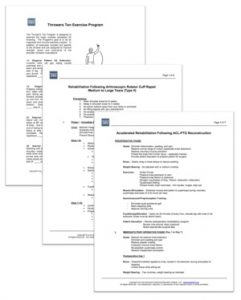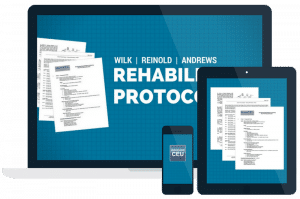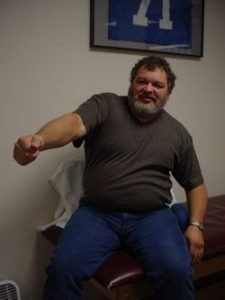There continues to be great debate over the most appropriate rehabilitation progression following rotator cuff repair. We’ve done a great job improving our strategies for shoulder impingement treatment, however, rotator cuff injuries do continue to progress to full thickness tears.
Although our surgical techniques have gradually progressed from full open repairs, to smaller mini-open repairs, to the current standard all-arthroscopic repairs, many clinicians continue to utilize the same rehabilitation guidelines from past invasive procedures.
And more confusing is the lack of consensus among surgeons regarding the optimal postoperative rehabilitation protocol following arthroscopic rotator cuff repair. Protocols can vary as drastically as beginning gentle passive range of motion and isometric exercises post-operative week 1 to delaying 12 weeks for the initiation of similar exercises.
I want to share the postoperative protocol that I have developed with Kevin Wilk and James Andrews.
It details the postoperative guidelines that we have used since the shift to arthroscopic rotator cuff repairs several years ago. While there is still a lack of efficacy studies, these guidelines have proven to us to be both safe and effective in the rehab of 1000’s of patients at our clinics.
Before downloading the protocol, I want to explain the goals of rehabilitation and what I believe are the 3 keys to rehabilitation. These principles are the cornerstone behind the protocol you are about to download.
Goals of Rehabilitation Following Rotator Cuff Repair
When rehabilitating after an arthroscopic rotator cuff repair surgery, the main goals of the rehabilitation protocol should be:
- Protect the integrity of the rotator cuff repair
- Minimize postoperative pain and inflammation
- Restore passive range of motion
- Restore strength and dynamic stability of the shoulder
- Restore active range of motion
- Return to functional activities
Pretty simple, right? When you lay it out like that, we simply combine those goals with what we know about the basic science of healing tissue and you can fill in the gaps and individualize a program based on the patient and your treatment preferences.
The 3 Most Important Keys to Rotator Cuff Repair Rehabilitation
Now that you understand the goals, I want to share what I consider the 3 most important keys to rotator cuff repair rehabilitation. Follow the goals above and focus on these 3 keys and you’ll be well on your way to full functional recovery:
Restore full passive ROM quickly. It is extremely easy to lose motion following surgery. In my opinion this is caused by scarring in the subacromial space as well as loss of the redundancy of the glenohumeral capsule with immobilization. This is one of the common “rookie mistakes” I see with students and new graduates. Passive range of motion should be initiated immediately following surgery in a gradual and cautious fashion. Studies have shown that passive range of motion into flexion and external rotation actually decreases strain in the rotator cuff repair (still need to be cautious with adduction, extension, and internal rotation).
- Restore dynamic humeral head control. This is likely the most important goal of postoperative rehabilitation, other than maintaining the integrity of the repair. What this means is to restore the rotator cuff’s ability to center the humeral head within the glenoid fossa. Have you ever seen a patient following repair that had a shoulder “shrug” sign? That is caused by the inability of the cuff to compress the humeral head and the resultant superior humeral head migration. This is why it is imperative to begin gentle isometrics, rhythmic stabilization drills, and other drills to re-educate the rotator cuff.
- Maximize external rotation strength. I often refer to external rotation as the key to the shoulder. Weakness of ER is common in almost every pathology and strengthening of the area is extremely important to balance the anterior and posterior balance of cuff. Several studies have shown that ER strength takes the longest amount of time to restore after rotator cuff repair. The longer this area is weak, the more difficult it will be to stabilize the joint.
Rehabilitation Protocol Following Arthroscopic Rotator Cuff Repair

They are the most widely used and respected rehabilitation protocols today.
Want to see what our protocols include? You can download our 3 most popular protocols for FREE:
- Accelerated rehabilitation following ACL reconstruction using a patellar tendon autograft
- Rehabilitation following arthroscopic rotator cuff repair for a type II medium-large sized tear
- Thrower’s ten exercise program

If you work in an outpatient orthopedic or sports medicine clinic, these protocols are an invaluable resource to help guide your treatment approach.



 Restore full passive ROM quickly. It is extremely easy to lose motion following surgery. In my opinion this is caused by scarring in the subacromial space as well as loss of the redundancy of the glenohumeral capsule with immobilization. This is one of the common “rookie mistakes” I see with students and new graduates. Passive range of motion should be initiated immediately following surgery in a gradual and cautious fashion. Studies have shown that passive range of motion into flexion and external rotation actually decreases strain in the rotator cuff repair (still need to be cautious with adduction, extension, and internal rotation).
Restore full passive ROM quickly. It is extremely easy to lose motion following surgery. In my opinion this is caused by scarring in the subacromial space as well as loss of the redundancy of the glenohumeral capsule with immobilization. This is one of the common “rookie mistakes” I see with students and new graduates. Passive range of motion should be initiated immediately following surgery in a gradual and cautious fashion. Studies have shown that passive range of motion into flexion and external rotation actually decreases strain in the rotator cuff repair (still need to be cautious with adduction, extension, and internal rotation).


